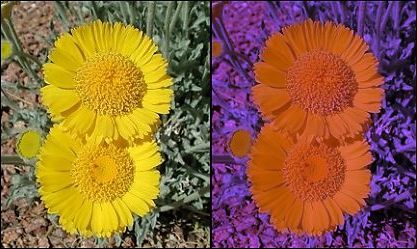

Not surprisingly, we think we see with our eyes, and in a sense, we do. But looked at another way, we really see with our brain. We've all been told one time or another that our eye is like a camera, with the retina acting as the film. But the next sentence usually is something like "the picture is then sent to the brain". Somehow, it seems the analogy breaks down here, unless you're into sending out retinas for developing.
What gets sent to the brain is a complex series of electrical nerve
impulses. It's up to the brain to make sense of them. Why, if similar nerve
impulses from the ears were sent to the sight centers, we'd see sound! Our
translation doesn't necessarily accurately reflect the world around us, but instead
is processed for our survival needs. The colors we see, for example, are abstract
concepts. Sure, yellow is characterized as such and such a wavelength—but it's our
brain that provides the sensation of yellowness. Who knows what your favorite Martian
might see it as?

Contributor: Arthur H. Harris, Laboratory for Environmental Biology, Centennial Museum, University of Texas at El Paso.
Desert Diary is a joint production of the Centennial Museum and KTEP National Public Radio at the University of Texas at El Paso.

On the left, a Desert Marigold as we see it; on the right, as your favorite Martian might perceive it.